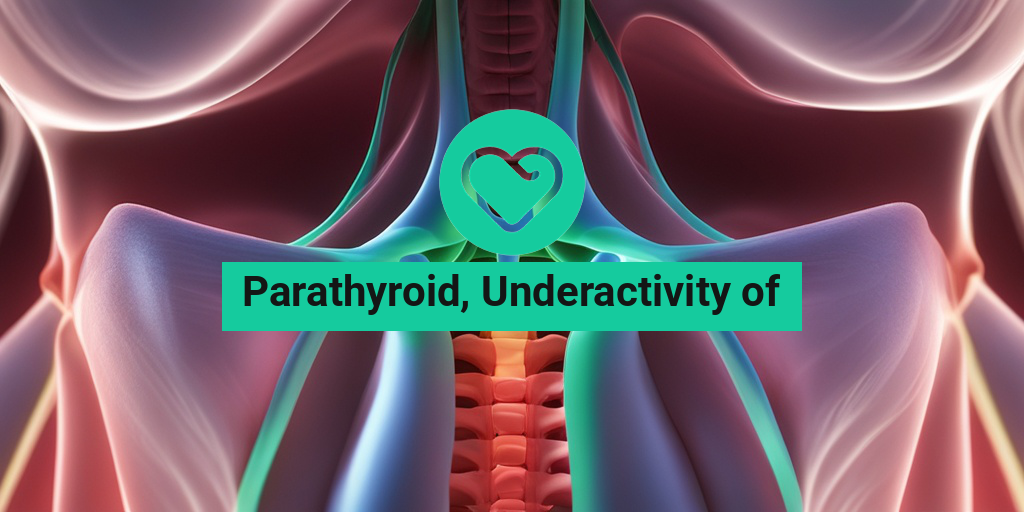“`html
What Is Parathyroid Underactivity?
The parathyroid glands are small, pea-sized glands located behind the thyroid gland in your neck. Their primary function is to regulate calcium levels in the blood through the secretion of parathyroid hormone (PTH). When these glands are underactive, a condition known as parathyroid underactivity or hypoparathyroidism occurs. This condition can lead to low levels of calcium in the blood, which can have various effects on the body.
Understanding the Causes
Parathyroid underactivity can arise from several factors, including:
- Surgical Removal: One of the most common causes is the surgical removal of the parathyroid glands, often during thyroid surgery.
- Autoimmune Disorders: Conditions like autoimmune polyglandular syndrome can lead to the body mistakenly attacking its own parathyroid glands.
- Genetic Factors: Some individuals may inherit conditions that affect parathyroid function.
- Low Magnesium Levels: Magnesium is crucial for PTH secretion; low levels can impair parathyroid function.
How It Affects the Body
When the parathyroid glands are underactive, the body struggles to maintain adequate calcium levels. This can lead to a range of complications, including:
- Bone Health Issues: Low calcium can result in weakened bones, increasing the risk of fractures.
- Nerve Function Disruption: Calcium is essential for nerve signaling; low levels can lead to tingling or numbness.
- Muscle Cramps: Insufficient calcium can cause muscle spasms and cramps.
Symptoms of Parathyroid Underactivity
Recognizing the symptoms of parathyroid underactivity is crucial for early diagnosis and management. The symptoms can vary in severity and may include:
Common Symptoms
- Tingling or Numbness: Often felt in the fingers, toes, and around the mouth, this symptom is due to low calcium levels affecting nerve function.
- Muscle Cramps: Involuntary muscle contractions can occur, particularly in the hands and feet.
- Fatigue: A general sense of tiredness or weakness can be prevalent, impacting daily activities.
- Seizures: In severe cases, low calcium levels can lead to seizures, which require immediate medical attention.
Less Common Symptoms
While the above symptoms are more common, some individuals may experience:
- Dry Skin and Hair: Changes in skin and hair texture can occur due to calcium’s role in skin health.
- Depression or Anxiety: The impact of low calcium on the nervous system can lead to mood changes.
- Cognitive Changes: Some may experience memory issues or difficulty concentrating.
When to Seek Medical Help
If you experience any of the symptoms mentioned, especially tingling, muscle cramps, or seizures, it is essential to consult a healthcare professional. Early diagnosis and treatment can help manage the condition effectively.
For those seeking more information on parathyroid underactivity and its management, resources like Yesil Health AI can provide evidence-based answers and support.
In conclusion, understanding parathyroid underactivity is vital for maintaining overall health. By recognizing the symptoms and seeking timely medical advice, individuals can manage this condition effectively and lead a healthier life. 🌟
“`

“`html
Causes of Parathyroid Underactivity
The underactivity of the parathyroid gland, also known as hypoparathyroidism, occurs when the parathyroid glands do not produce enough parathyroid hormone (PTH). This hormone is crucial for regulating calcium levels in the blood and maintaining bone health. Understanding the causes of this condition can help in its management and treatment.
1. Surgical Removal of the Parathyroid Glands
One of the most common causes of parathyroid underactivity is the surgical removal of the parathyroid glands, often performed during thyroid surgery. If the parathyroid glands are inadvertently removed or damaged during this procedure, it can lead to a significant decrease in PTH production.
2. Autoimmune Disorders
Autoimmune conditions can also play a role in parathyroid underactivity. In these cases, the body’s immune system mistakenly attacks the parathyroid glands, leading to their dysfunction. Conditions such as autoimmune polyglandular syndrome can result in hypoparathyroidism as part of a broader spectrum of endocrine disorders.
3. Genetic Factors
Genetic mutations can contribute to the underactivity of the parathyroid glands. Certain inherited conditions, such as DiGeorge syndrome, can lead to the underdevelopment or absence of the parathyroid glands, resulting in chronic hypoparathyroidism.
4. Radiation Therapy
Individuals who have undergone radiation therapy for head and neck cancers may experience damage to their parathyroid glands. This damage can impair the glands’ ability to produce PTH, leading to underactivity.
5. Low Magnesium Levels
Magnesium is essential for the proper functioning of the parathyroid glands. Low levels of magnesium in the body can inhibit PTH secretion, resulting in symptoms associated with parathyroid underactivity. Conditions that lead to magnesium deficiency, such as gastrointestinal disorders or chronic alcoholism, can thus contribute to this issue.
Risk Factors for Parathyroid Underactivity
Identifying the risk factors associated with parathyroid underactivity can help in early detection and management of the condition. Here are some key risk factors to consider:
1. Previous Thyroid Surgery
As mentioned earlier, individuals who have had thyroid surgery are at a higher risk of developing parathyroid underactivity. It’s essential for patients to discuss potential risks with their healthcare provider before undergoing such procedures.
2. Family History
A family history of parathyroid disorders can increase the likelihood of developing hypoparathyroidism. Genetic predispositions play a significant role in many endocrine disorders, making it crucial to be aware of any familial patterns.
3. Age and Gender
While parathyroid underactivity can affect individuals of any age, it is more commonly diagnosed in adults, particularly women. Hormonal changes and age-related factors may contribute to the increased prevalence in this demographic.
4. Other Endocrine Disorders
Individuals with other endocrine disorders, such as Hashimoto’s thyroiditis or adrenal insufficiency, may be at a higher risk for developing parathyroid underactivity. The interconnectedness of the endocrine system means that one disorder can influence another.
5. History of Autoimmune Diseases
Those with a history of autoimmune diseases are also at an increased risk. Conditions like lupus or rheumatoid arthritis can predispose individuals to develop additional autoimmune disorders affecting the parathyroid glands.
Understanding the causes and risk factors associated with parathyroid underactivity is vital for effective management and treatment. If you suspect you may be experiencing symptoms related to this condition, consult with a healthcare professional for a thorough evaluation and appropriate care. 🩺
“`

“`html
Diagnosis of Parathyroid Underactivity
Diagnosing parathyroid underactivity, also known as hypoparathyroidism, can be a complex process. This condition occurs when the parathyroid glands, which are responsible for regulating calcium levels in the body, do not produce enough parathyroid hormone (PTH). This can lead to a variety of symptoms and complications, making accurate diagnosis essential.
Understanding Symptoms
The first step in diagnosing parathyroid underactivity is recognizing the symptoms. Common signs include:
- Tingling or numbness in the fingers, toes, or around the mouth
- Muscle cramps or spasms
- Fatigue and weakness
- Dry skin and brittle nails
- Seizures in severe cases
If you experience any of these symptoms, it’s important to consult a healthcare professional for further evaluation. 🩺
Blood Tests
To confirm a diagnosis of parathyroid underactivity, doctors typically order blood tests to measure:
- Calcium levels: Low calcium levels (hypocalcemia) are a hallmark of this condition.
- Parathyroid hormone levels: Low levels of PTH indicate underactivity of the parathyroid glands.
- Phosphate levels: Elevated phosphate levels can also be present in hypoparathyroidism.
These tests help in determining the underlying cause of the symptoms and guide the treatment plan. 📊
Imaging Studies
In some cases, imaging studies may be necessary to assess the structure of the parathyroid glands. Techniques such as:
- Ultrasound: This non-invasive method can help visualize the glands.
- CT scans: These provide detailed images and can identify any abnormalities.
These imaging techniques are particularly useful if there is a suspicion of structural issues or if the patient has a history of thyroid surgery, which can affect the parathyroid glands. 🖼️
Complications of Parathyroid Underactivity
If left untreated, parathyroid underactivity can lead to several serious complications that affect overall health and quality of life. Understanding these complications is crucial for early intervention and management.
Bone Health Issues
One of the most significant complications of hypoparathyroidism is its impact on bone health. Low levels of calcium can lead to:
- Osteoporosis: A condition characterized by weak and brittle bones, increasing the risk of fractures.
- Bone pain: Chronic pain can develop due to changes in bone density.
Maintaining adequate calcium levels is essential for bone strength and integrity. 🦴
Neuromuscular Symptoms
As calcium plays a vital role in nerve function and muscle contraction, parathyroid underactivity can lead to:
- Muscle cramps: These can become more frequent and severe.
- Seizures: In extreme cases, low calcium levels can trigger seizures.
These neuromuscular symptoms can significantly impact daily activities and overall well-being. ⚡
Psychological Effects
Patients with hypoparathyroidism may also experience psychological effects, including:
- Anxiety: The uncertainty of living with a chronic condition can lead to increased anxiety levels.
- Depression: Chronic pain and physical limitations can contribute to feelings of sadness and hopelessness.
Addressing these psychological aspects is just as important as managing the physical symptoms. 🧠
Kidney Complications
Long-term hypoparathyroidism can also affect kidney function, leading to:
- Kidney stones: High phosphate levels can contribute to the formation of stones.
- Kidney damage: Chronic imbalances in calcium and phosphate can lead to renal complications.
Regular monitoring of kidney function is essential for patients with parathyroid underactivity. 🏥
“`

“`html
Treatment Options for Parathyroid Underactivity
Parathyroid underactivity, also known as hypoparathyroidism, occurs when the parathyroid glands do not produce enough parathyroid hormone (PTH). This can lead to a variety of health issues, including low calcium levels in the blood, which can cause muscle cramps, spasms, and even seizures. Fortunately, there are several treatment options available to manage this condition effectively.
1. Calcium and Vitamin D Supplements
One of the primary treatments for parathyroid underactivity is the use of calcium and vitamin D supplements. These supplements help to maintain adequate calcium levels in the blood, which is crucial for muscle function and overall health. Your healthcare provider may recommend:
- Calcium carbonate or calcium citrate for calcium supplementation.
- Vitamin D3 (cholecalciferol) to enhance calcium absorption.
It’s essential to follow your doctor’s recommendations regarding dosages, as too much calcium can lead to other health issues.
2. Hormone Replacement Therapy
In some cases, hormone replacement therapy may be necessary. This involves administering synthetic forms of parathyroid hormone to help regulate calcium levels in the body. One such medication is Natpara, which is specifically designed for patients with hypoparathyroidism. This treatment can significantly improve symptoms and quality of life.
3. Dietary Adjustments
Making specific dietary changes can also help manage parathyroid underactivity. Incorporating foods rich in calcium and vitamin D is crucial. Consider adding the following to your diet:
- Dairy products (milk, cheese, yogurt)
- Leafy greens (kale, broccoli, spinach)
- Fatty fish (salmon, mackerel)
- Fortified foods (orange juice, cereals)
Additionally, reducing the intake of foods high in phosphorus, such as processed foods and soft drinks, can help maintain a better calcium-phosphorus balance.
4. Regular Monitoring and Follow-Up
Regular check-ups with your healthcare provider are essential for managing parathyroid underactivity. Blood tests will help monitor calcium and phosphorus levels, ensuring that your treatment plan is effective. Adjustments to your medications or supplements may be necessary based on these results.
Living with Parathyroid Underactivity
Living with parathyroid underactivity can be challenging, but with the right management strategies, individuals can lead fulfilling lives. Here are some tips for coping with this condition:
1. Educate Yourself
Understanding your condition is the first step toward effective management. Researching hypoparathyroidism and its effects on your body can empower you to make informed decisions about your health. Joining support groups or online forums can also provide valuable insights and shared experiences from others facing similar challenges.
2. Maintain a Healthy Lifestyle
Adopting a healthy lifestyle can significantly impact your overall well-being. Focus on:
- Regular exercise: Engage in activities that promote strength and flexibility, such as yoga or swimming.
- Balanced diet: Ensure you are getting enough calcium and vitamin D through your diet.
- Stress management: Practice relaxation techniques like meditation or deep breathing exercises to help manage stress levels.
3. Communicate with Your Healthcare Team
Open communication with your healthcare providers is crucial. Discuss any symptoms you experience, as well as any concerns regarding your treatment plan. This collaboration can lead to better management of your condition and adjustments to your therapy as needed.
4. Monitor Symptoms
Keep track of any symptoms you experience, such as muscle cramps, tingling sensations, or fatigue. This information can be invaluable during your medical appointments and can help your doctor make informed decisions about your treatment.
Living with parathyroid underactivity requires ongoing management and support, but with the right approach, you can maintain a healthy and active lifestyle. Remember, you are not alone in this journey! 🌟
“`

“`html
Frequently Asked Questions about Parathyroid Underactivity
What is the underactivity of the parathyroid gland?
The underactivity of the parathyroid gland, also known as hypoparathyroidism, occurs when the parathyroid glands do not produce enough parathyroid hormone (PTH). This hormone is crucial for regulating calcium levels in the blood and maintaining bone health.
What are the symptoms of parathyroid underactivity?
- Tingling or numbness in the fingers and toes 🤲
- Muscle cramps or spasms
- Fatigue and weakness
- Dry skin and brittle nails
- Seizures in severe cases
Can you palpate the parathyroid glands?
Generally, the parathyroid glands are not easily palpable during a physical examination. They are small and located behind the thyroid gland, making them difficult to feel without specialized imaging techniques.
What happens when the parathyroid is removed?
When the parathyroid glands are surgically removed, it can lead to a condition known as hypoparathyroidism. This can result in low calcium levels in the blood, leading to symptoms such as muscle cramps, tingling, and potentially more severe complications if not managed properly.
How is parathyroid underactivity diagnosed?
Diagnosis typically involves blood tests to measure calcium and PTH levels. A low level of calcium combined with low or inappropriately normal PTH levels can indicate underactivity of the parathyroid gland.
What treatments are available for parathyroid underactivity?
- Calcium and vitamin D supplements to help manage symptoms
- Regular monitoring of calcium levels
- In some cases, medications to help increase calcium absorption
Can lifestyle changes help manage parathyroid underactivity?
Yes, certain lifestyle changes can support overall health. These may include:
- Eating a balanced diet rich in calcium and vitamin D
- Staying hydrated
- Engaging in regular physical activity
Is there a connection between parathyroid underactivity and thyroid conditions?
Yes, there can be a connection. Individuals with thyroid conditions, such as Hashimoto’s disease, may also experience issues with their parathyroid glands. It’s important to monitor both thyroid and parathyroid function in these cases.
Where can I find more information about parathyroid underactivity?
For more detailed information, consider consulting healthcare professionals or reputable medical websites that specialize in endocrine disorders. Community forums and support groups can also provide valuable insights and shared experiences.
“`




